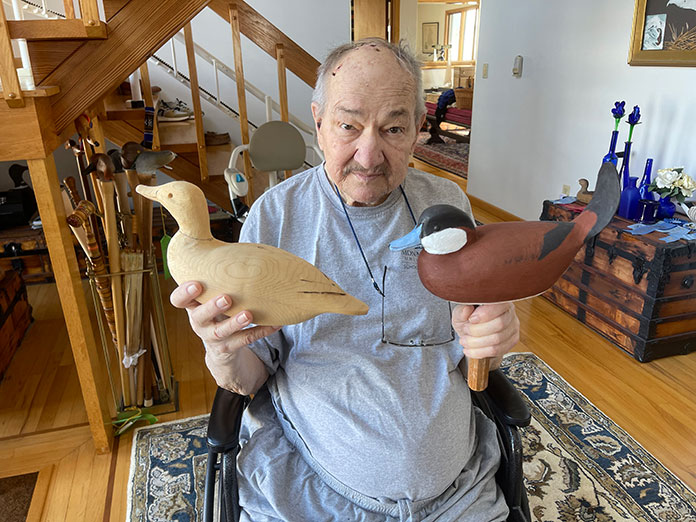
BRICK – The art of waterfowl decoy carving has its roots as a useful hunting tool, and they are crafted to be as realistic as possible and are designed to imitate either the game species or prey species of what is being hunted.
While rarely used these days due to manufacturing and technology advances, the wooden decoys are highly collectable as folk art and are prized by collectors as decorative items.
Shore Acres resident Denis E. Hruza, 78, who has a PhD. in regulatory chemistry, has carved about 100 waterfowl decoys in the last 30 years. Each one has won a local or statewide ribbon and 38 have won world ribbons.
Hruza and his wife Anne have lived in their waterfront home for 44 years, and he said he gets his inspiration from looking out the window.
First exposed to the art when he lived in Baywood next door to world-class carver Charles Mees, who was voted best in the world at one time, Hruza was also inspired by his former father-in-law Roy Tilton.
Hruza is a member of two carving clubs: NJ Wildfowl Carvers Association and NJ Decoy Collectors Association.

There are two types of waterfowl decoys: utilitarian gunning decoys usually have a weighted lead plate on the bottom and are hollowed out so they will upright themselves if they flip over in the bay. Hruza said they take about 80 hours to carve and paint.
The second type, decorative decoys, have greater aesthetic details, such as realistic feathers and color shading that have been added with a burning pen, which is why Hruza said they can take up to 500 hours to complete.
He said he uses a hardwood, Atlantic white cedar from New Jersey or pine for the gunning decoys, and Tupelo wood from Louisiana for the decorative decoys.
Hruza paints his decoys with oil paint since it takes longer to dry than acrylic paint and allows him the ability to take his time while blending.
Award winning decoys have several commonalities: the shape and the size have to be accurate, and it has to have the right basic colors “or you’re not going to attract another bird, because if it’s flying high it’s not going to work,” he said. Carvers use pattern books that give the specifics for each bird.
The gunning decoys are also judged on how they work in the water.
“They have to float right, and if they flip over they have to flip back over,” Hzruka said. The decorative decoys do not float and are not judged on how they work in the water.
There are about 50 different classes for judging decoys, and birds entered into competitions must have been carved that year, he said.
The process of creating a decoy starts with a block of wood, which is carved into the approximate body shape. The head is carved separately.
Then the body is cut in half, hollowed out (for buoyancy) and glued back together with epoxy. Afterwards, Hruza finishes the carving on the outside and glues the head on.
Gunning decoys have a small piece of wood, a penny, a pea or dried bean inside to prove they’re hollow when shaken.
Oftentimes Hzruka carves his gunning decoys in their mating form.

“When they’re not mating they’re very bland,” he said. “It’s when the male bursts into color, they get brighter because they go through a molting phase when they lose all their old feathers and grow new bright colors for mating season in the spring.”
The females remain bland because they have to sit on the nest so they blend in with the reeds and the grasses, Hruza said.
In the past, decoy competitions were held in Toms River, Manasquan, Red Bank and other NJ towns, but now the only competition is held in Tuckerton during the annual Barnegat Bay Decoy and Gunning Show, a weekend event held in Tuckerton every September.
“The biggest problem they have now is they have a hard time finding new people – the kids don’t want to carve – they’re more interested in their cell phones, iPads and laptops.
“Everything’s dried up – even Tuckerton is starting to wane because most of the carvers are dying off.”
It could be because less people are hunting in New Jersey. There are more carvers in Maryland, Virginia and North Carolina where there is more hunting, he said.
“We tried heavily for five years to recruit the kids through a program at the Tuckerton Seaport & Baymen’s Museum – we have the youth carvers for 18-19 year old kids, but they’re mainly from Tuckerton and Waretown, there’s nobody from up here.”
Carving classes are still offered there once a year in the fall.

There are many talented women carvers who have won world ribbons, Hruza said.
“Women love to carve songbirds, and they love to do stylistic carving, like they’ll take a big piece of driftwood and at the end there will be a bird coming out of it,” he said.
His favorite waterfowl to carve is a hooded merganser because he sees them all winter long in his lagoon.
Populations of the mallard duck, commonly seen at the Jersey Shore, vary from year-to-year because of heavy rains in the midwest.
“The rainwater flooded all the potholes – or the little indentations in the prairies where they nest – which is where the New Jersey mallards come from,” he said. “If there was a normal amount of water there would be a lot of mallards.
“I try to carve what I see in the backyard,” Hzruka said “Carving gives me a lot of pleasure.”





